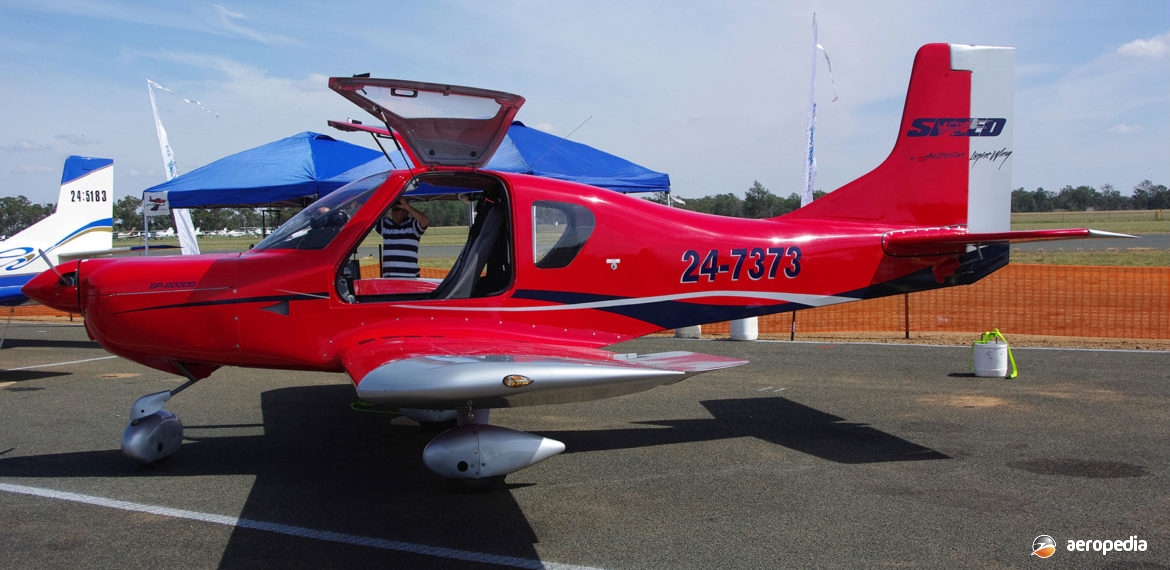Photograph:
Hughes Lightwing Speed SP2000 24-7373 (c/n 011) at Temora, NSW in April 2010 (David C Eyre)
Country of origin:
Australia
Description:
Two / four-seat light touring monoplane
Power Plant:
(SP3000)
One 134 kw (180 hp) Lycoming IO-360-B1A2 four-cylinder horizontally-opposed air-cooled engine
Specifications:
- Wingspan: 7.87 m (25 ft 8 in)
- Length: 6.42 m (21 ft)
- Height: 2.52 m (8 ft 3 in)
- Wing area: 11.81 m² (127.12 sq ft)
- Max cruising speed at 3,048 m (10,000 ft): 306 km/h (190 mph)
- Stalling speed: 83 km/h (52 mph)
- Initial rate of climb: 305 m/min (1,000 ft/min)
- Take-off distance over 15 m (50 ft) obstacle: 400 m (1,312 ft)
- Range with reserve: 4 hrs
- Fuel capacity: 180 litres (39.6 Imp gals)
- Empty weight: 500 kg (1,102 lb)
- Useful load weight: 300 kg (661 lb)
- Loaded weight: 800 kg (1,764 lb)
History:
The Lightwing Speed was designed and built by the Hughes Lightwing Compant at Ballina, NSW to be produced in kit form for the light aircraft market. It was produced in four basic versions, the two-seater known as the SP2000-S which was a lightweight model for registration under Recreational Aviation Australia Regulations (RAA) and had a wing area of 11.81 m² (127.12 sq ft); the SP3000 with a 119 kw (160 hp) Lycoming O-320 engine, registered under the Experimental Category and having a wingspan of 7.4 m (24 ft 2 in) with a max take-off weight of 700 kg; the SP4000 a four-seater with a wingspan of 8.3 m (27 ft 6 in), a wing area of 13.15 m² (141.55 sq ft) and a loaded weight of 900 kg (1,984 lb) ; and the SP-GT, a two-seat variant using the Light Sport 220 engine, registered under the Experimental Category, aimed at the glider tug market.
Development commenced in 2002, the Company stating it planned to provide its own designed-and-built power plant for the series, this being known initially as the Light Sport Power 200 LW230 liquid-cooled unit with a 2.1:1 gearbox with a turbocharger, an intercooler, and the ability to run on Avgas or premium unleaded petrol, later becoming known as the Light Sport 220. The Subaru EJ-20 engine converted by Lightwing with additional fuel pump switches was also available. All variants were available with tailwheel or tricycle undercarriage. The SP4000 could be registered in the Experimental or General Aviation category.
The wings were of metal construction with some fabric covering, the control surfaces being fabric covered and mass balanced. The elevator had a pushrod action, the rudder was cable operated, and the three-stage flaps were mechanical. Entry was by two gull-wing doors and instrumentation was a glass cockpit with an LCD screen, the hard drive for which had charts of all of Australia. Fuel was contained in two wing tanks, being 180 litres (40 Imp gals) in the four-seater and 160 litres (35 Imp gals) in the two-seater. The two-seater was available only in kit form and could be registered under RAA or Experimental regulations. The four-seater was available as a complete aircraft and was registered under general aviation experimental regulations.
The prototype of the Speed, powered by a Rotax 914 engine and seating two, flew for the first time in July 2005. By mid 2005 it had been decided to offer it in kit form with the Rotax 912S, Rotax 914 turbocharged, Lycoming or Light Sport 220 engines. Further engines became available, including the turbo-boosted Subaru EJ-20 which provided 149 kw (200 hp), and the Mistral series which provided from 134 kw (180 hp) to 186 kw (250 hp). Amphibious floats were available.
The Light Sport 220 engine was a conversion of the Subaru EJ-20 quad-cam turbocharged unit, the modifications including a stainless steel exhaust system, MOTEC engine management and an Australian Lightwing gearbox. With this engine the Speed had a cruising speed of 241 km/h (150 mph). As an option the Company provided a Global Navigation and Terrain Mapping unit which provided computer-aided navigation through an onboard 25.4 cm (10 in) PC.
The prototype 19-4353 (c/n 001), known as the SP-2000S, with a 75 kw (100 hp) Rotax 912 engine, first flew in mid 2005 and was used to test other engines proposed for the series. Control was by side-stick and cruising speed at 75 per cent power at 5,200 rpm using 18 litres (3.96 Imp gals) of fuel per hour was 204 km/h (127 mph).
On 5 August 2008 Airgyro, the American distributor, at Oshkosh in Wisconsin received the SLSA Certificate of Airworthiness for the SP2000 Outback, the name given to the type in the United States.

